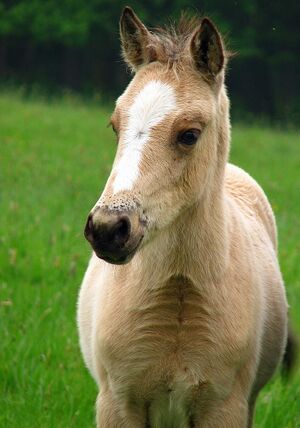Equine Development of Gut Microbiota

By Mira Allen
Topic: equine development of gut microbiota
Sample citations: [1]
[2]
A citation code consists of a hyperlinked reference within "ref" begin and end codes.
To repeat the citation for other statements, the reference needs to have a names: "<ref name=aa>"
The repeated citation works like this, with a forward slash.[1]
Introduction
In utero, horses intestinal tracts are close to sterile. Soon after birth, however, microbial colonization skyrockets. Proper colonization lasts about 50 days, and is incredibly important as improper microbial gut content can result in dysbiosis, causing inflammation and metabolic disease [1]. Equine hind-gut microbiota enable nutritional optimization from an otherwise nutrient-poor foraging diet via plant material fermentation [2]. The initial colonization, stabilization, and then weaning period (4-6 months old) as a foal transfers to solid food are important periods in establishing the microbial composition of the colon [1].
Every point of information REQUIRES CITATION using the citation tool shown above.
Gut Colonization: Birth to Maturity
The stages of microbiome colonization in mammals are as follows:
- Initial colonization [1]
- Microbiota stabilization [1]
- Weaning (in foals: 4-6 months) [1]
- Transfer to solid foods (occurs gradually) [1]
While these are generally applicable in mammals, it has been demonstrated that the foal gut microbiome closely resembles their mother's around 60 days of age [1]. This means that their microbiome development occurs more rapidly than most other mammals. While it is unclear where colonization begins exactly, it is likely in utero, and if not, in the birth canal [1]. This is then furthered via the consumption of mare's milk and manure [1]. Manure consumption occurs most commonly until about 2 months of age [1].
Before 50 days old, gut microbiota composition is transient and dynamic. Research [1] has shown that change in similarity between individual foals and foals and adults occurs in these stages:
Day 7: large variation between individual foals
Day 20: more consistent between foals, but different from adults
Day 50: very similar to adult composition
Microbiome Species
The core mature equine microbiome that has so far been documented to include:
- Bacteroides uniformis [1]
- Bacteroides fragilis [1]
- Parabacteroides [1]
- Butyricimonas (all Bacteroidetes)[1]
- Enterobacteriaceae (Proteobacteria) [1]
- Lactobacillus mucosae [1]
- Blautia producta [1]
- Streptococcus (all Firmicutes) [1]
Section 4
Conclusion
References
- ↑ Jump up to: 1.0 1.1 1: https://doi.org/10.1038%2Fs41598-019-50563-9
2: https://doi.org/10.1186/s42523-019-0013-3
Hodgkin, J. and Partridge, F.A. "Caenorhabditis elegans meets microsporidia: the nematode killers from Paris." 2008. PLoS Biology 6:2634-2637.] - ↑ Bartlett et al.: Oncolytic viruses as therapeutic cancer vaccines. Molecular Cancer 2013 12:103.
Authored for BIOL 238 Microbiology, taught by Joan Slonczewski,at Kenyon College,2024
